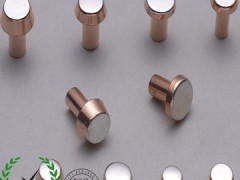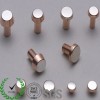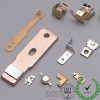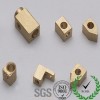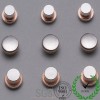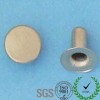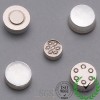Hot Selling Bimetal Rivets, Bi-metal Rivets
Product overview:
The material of composite rivet's working layer is more flexible to choose than the solid precious metal rivet's, even though the precious alloy material has excellent electrical contact property. Rivet contact is suitable for the continuous automatic production of riveting and processing. It doesn't need other processing technique(such as electroplating, welding, etc). So, it not only simplified the manufacturing process of contact comonent, improve the productivity and lower the cost, but also increase the assembling precision and reliability of the
component.
Main Materials:Ag/Cu, AgCdO/Cu, FAg/Cu, AgNi/Cu, AgSnO2/Cu, AgSnO2In2O3/Cu, etc.
Specifications of Bi-metal Rivets:
|
Items
|
Limit Deviation
|
Basic Dimension
|
||||||||||
|
Head Diameter/mm
|
±0.1
|
2.5
|
3
|
3.5
|
4
|
4.5
|
5
|
5.5
|
6
|
6.5
|
7
|
8
|
|
Head Thickness/mm
|
±0.05
|
0.6
0.8
1.0
|
0.8
1.0
1.2
|
1.0
1.2
1.5
|
1.0, 1.2
1.5, 2.0
|
1.2, 1.5, 2.0
|
||||||
|
Head Layer/mm
|
S<0.4±0.060
S>0.4±0.060
|
0.3-0.4
|
0.35-0.50
|
0.40-0.60
|
0.50-0.70
|
|||||||
|
Shank Diameter/mm
|
-0.02
-0.10
|
1.2
1.5
|
1.5
|
1.5
2.0
|
2.0
|
2.0
2.5
|
2.5
|
2.5
3.0
|
3.0
|
3.0
3.5
|
3.5
|
4.0
|
|
Shank Length/mm
|
+0.150
|
1-2.0
|
1-3.0
|
|||||||||
|
Spheric Radius/mm
|
R<6±1
R>6±2
|
4
6
|
6
8
|
8
10
|
10
15
|
15
20
|
20
25
|
|||||
|
Demoulding Angle
|
±2
|
9,10,11,12
|
||||||||||

